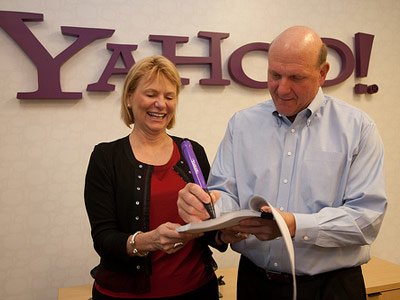
See Also:

Microsoft Is Redoing Bing To Look More Like The New Windows Design

Microsoft’s Windows Revenue Comes In Light, But It Still Crushes Earnings

Now Apple Is Talking About Buying Hulu
Yahoo’s search revenue has been declining at an alarming rate and was down 15% from the previous year in the second quarter.
Microsoft’s Online division (which is mostly Bing) is also burning through billions, and its search revenue isn’t rising as fast as expected.
Meanwhile, Google continues to turn in amazing results quarter after quarter — last quarter, revenue from Google Sites (mostly search) was up 39% from the previous year. So it’s not a problem with the search market in general.
On their last two earnings calls, both Microsoft and Yahoo have said that revenue per search is lower than they expected.
Why is this happening?
The two most obvious reasons would be (a.) fewer people are clicking on the search ads provided by Microsoft’s adCenter platform than were clicking on the ads provided by Yahoo’s Panama platform or (b.) advertisers aren’t paying as much for each ad.
In fact, the main problem may be more complicated — and hard to fix.
Mark Ballard, an analyst at online marketing firm Rimm-Kaufman Group, dug into the problem a little bit based on data that RKG collected from its paid search clients. He thinks that Microsoft doesn’t do a very good job of matching inexact queries with search ads.
As a result, a lot of searches that should have ads are coming up with no ads. That’s an inventory problem.
Ballard explained that they measure three kinds of paid clicks. Say an advertiser buys the search term “pancake syrup.” If I search on “pancake syrup” and click an ad, that’s an exact match. If I search on “Vermont pancake syrup,” that’s a phrase match — the phrase contains the exact keyword.
But if I search on another similar term, like “breakfast,” and the ad based on the keyword “pancake syrup” comes up, that’s a broad match.
Back when Yahoo was running Panama, 60% of the clicks that RKG measured on Yahoo were for broad matches. Now, only 40% are.
That means a lot of searches that used to show ads are not showing ads now.
The obvious solution for Microsoft and Yahoo is to tweak the algorithms so that adCenter displays more ads for searches that aren’t exact matches. That could reduce the effectiveness of some ads, but will increase the overall number of ads displayed — and hopefully drive up revenue per search.
It’s a tricky balance — and one that Google has optimized almost perfectly.
Ballard also pointed to two other areas where Microsoft needs to do more to catch up with Google:
- New types of ad formats, like product ads that include images.
- Getting more partners to embed Bing search results — and ads — on their sites. Microsoft has been very aggressive about getting deals where users are guided directly to Bing, like the deal with toolbar maker Conduit. But it’s not doing as well as Yahoo with these third-party partnerships, which can also drive a lot of ad traffic.
Yahoo had no comment on this issue, but pointed back to statements made on its last earnings call: the company has already closed 20% of the gap between expected revenue per search and actual revenue per search, and has worked with Microsoft on areas like campaign budgeting and click prediction models. It expects revenue on adCenter to reach parity with the old Panama platform by the end of 2011.
Microsoft’s David Pann, general manager of its search network, also pointed to joint improvements on campaign budgeting and click prediction models, and said that advertisers are seeing “strong” return on investment, query share, and clickthrough metrics. Of course, that’s exactly what would be expected if Microsoft is favoring ad relevance at the expense of inventory.
The takeaway: Google’s decade of growth makes search advertising look easy, but there’s a lot of work going on behind the scenes that is proving very hard for Microsoft to duplicate.
